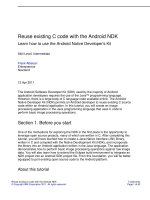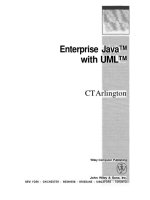Invoking Java Code with Invoking Java Code with JSP Scripting Elements
Bạn đang xem bản rút gọn của tài liệu. Xem và tải ngay bản đầy đủ của tài liệu tại đây (1.32 MB, 27 trang )
© 2010 Marty Hall
Invoking Java Code with
Invoking
Java
Code
with
JSP Scripting Elements
Ori
g
inals of Slides and Source Code for Examples:
/>Customized Java EE Training: />Servlets, JSP, JSF 2.0, Struts, Ajax, GWT 2.0, Spring, Hibernate, SOAP & RESTful Web Services, Java 6.
Developed and taught by well-known author and developer. At public venues or onsite at your location.
2
© 2010 Marty Hall
For live Java EE training, please see training courses
at
at
Servlets, JSP, Struts, JSF 1.x, JSF 2.0, Ajax (with jQuery, Dojo,
Prototype, Ext-JS, Google Closure, etc.), GWT 2.0 (with GXT),
Java 5, Java 6, SOAP-based and RESTful Web Services, Sprin
g
,
g
Hibernate/JPA, and customized combinations of topics.
Taught by the author of Core Servlets and JSP, More
Servlets and JSP
and this tutorial Available at public
Customized Java EE Training: />Servlets, JSP, JSF 2.0, Struts, Ajax, GWT 2.0, Spring, Hibernate, SOAP & RESTful Web Services, Java 6.
Developed and taught by well-known author and developer. At public venues or onsite at your location.
Servlets and JSP
,
and this tutorial
.
Available at public
venues, or customized versions can be held on-site at your
organization. Contact for details.
Agenda
• Static vs. dynamic text
• Dynamic code and good JSP design
• JSP expressions
• Servlets vs. JSP pages for similar tasks
• JSP scriptlets
• JSP declarations
• Predefined variables
• Comparison of expressions, scriptlets, and
declarations
XML syntax for JSP pages
•
XML
syntax
for
JSP
pages
4
© 2010 Marty Hall
Intro
Customized Java EE Training: />Servlets, JSP, JSF 2.0, Struts, Ajax, GWT 2.0, Spring, Hibernate, SOAP & RESTful Web Services, Java 6.
Developed and taught by well-known author and developer. At public venues or onsite at your location.
5
Uses of JSP Constructs
•
Scripting elements calling servlet
Scripting
elements
calling
servlet
code directly
• Scriptin
g
elements callin
g
servlet
Simple
Application
gg
code indirectly (by means of utility
classes)
B
•
B
eans
• Servlet/JSP combo (MVC)
MVC ith JSP i l
•
MVC
w
ith
JSP
express
i
on
l
anguage
• Custom tags
MVC ith b t t d
Complex
Application
•
MVC
w
ith
b
eans, cus
t
om
t
ags, an
d
a framework like Struts or JSF
6
Application
Design Strategy: Limit Java
Code in JSP Pages
Code
in
JSP
Pages
• You have two options
– Put 25 lines of Java code directly in the JSP page
– Put those 25 lines in a separate Java class and put 1 line
in the JSP page that invokes it
in
the
JSP
page
that
invokes
it
• Why is the second option much better?
– Develo
p
ment. You write the se
p
arate class in a
J
ava
p
pJ
environment (editor or IDE), not an HTML environment
– Debugging. If you have syntax errors, you see them
immediately at compile time Simple print statements can
immediately
at
compile
time
.
Simple
statements
can
be seen.
– Testin
g
. You can write a test routine with a loo
p
that
g
p
does 10,000 tests and reapply it after each change.
– Reuse. You can use the same class from multiple pages.
7
Basic Syntax
• HTML Text
H1 Bl h /H1
– <
H1
>
Bl
a
h
<
/H1
>
– Passed through to client. Really turned into servlet code
that looks like
• out.print("<H1>Blah</H1>");
• HTML Comments
–
<!
Comment
>
<!
Comment
>
– Same as other HTML: passed through to client
• JSP Comments
– <% Comment %>
– Not sent to client
•
Escaping <%
•
Escaping
<%
– To get <% in output, use <\%
8
Types of Scripting Elements
• Expressions
F
%i%
–
F
ormat: <
%
= express
i
on
%
>
– Evaluated and inserted into the servlet’s output.
I.e., results in something like out.print(expression)
Sitlt
•
S
cr
i
p
tl
e
t
s
– Format: <% code %>
–
Inserted verbatim into the servlet’s
_
j
s
p
Service method
(
called b
y
_
jp
(y
service)
• Declarations
–
Format:
<
%! code %
>
Format:
%!
code
%
– Inserted verbatim into the body of the servlet class, outside of any
existing methods
•
XML syntax
XML
syntax
– See slides at end of the lecture for an XML-compatible way of
representing JSP pages and scripting elements
9
© 2010 Marty Hall
JSP Expressions:
JSP
Expressions:
<%= value %>
Customized Java EE Training: />Servlets, JSP, JSF 2.0, Struts, Ajax, GWT 2.0, Spring, Hibernate, SOAP & RESTful Web Services, Java 6.
Developed and taught by well-known author and developer. At public venues or onsite at your location.
10
JSP Expressions
• Format
<%
JE i
%>
–
<%
=
J
ava
E
xpress
i
on
%>
• Result
– Ex
p
ression evaluated
,
converted to Strin
g,
and
p
laced
p, g,p
into HTML page at the place it occurred in JSP page
– That is, expression placed in _jspService inside out.print
•
Examples
•
Examples
– Current time: <%= new java.util.Date() %>
– Your hostname: <%= request.getRemoteHost() %>
• XML-compatible syntax
– <jsp:expression>Java Expression</jsp:expression>
–
You cannot mix versions within a single page You must
You
cannot
mix
versions
within
a
single
page
.
You
must
use XML for entire page if you use jsp:expression.
• See slides at end of this lecture
11
JSP/Servlet Correspondence
• Original JSP
<
H1>A Random Number</H1>
<%= Math.random() %>
• Representative resulting servlet code
public void _jspService(HttpServletRequest request,
Htt
p
ServletRes
p
onse res
p
onse
)
ppp)
throws ServletException, IOException {
response.setContentType("text/html");
Htt
p
Session session = re
q
uest.
g
etSession
();
p q g ();
JspWriter out = response.getWriter();
out.println("<H1>A Random Number</H1>");
out.
p
rintln(Math.random());
p
}
12
JSP Expressions: Example
…<BODY>
2S i /2
<
H
2
>J
S
P Express
i
ons<
/
H
2>
<UL>
<LI>Current time: <%= new java.util.Date() %>
<
LI>Server:
<
%= application.getServerInfo() %
>
<LI>Session ID: <%= session.getId() %>
<LI>The <CODE>testParam</CODE> form parameter:
<
%= request.getParameter("testParam") %
>
</UL>
</BODY></HTML>
13
Predefined Variables
• request
– The HttpServletRequest (1st argument to service/doGet)
• response
Th H S l R (2 d i /d G )
–
Th
e
H
ttp
S
erv
l
et
R
esponse
(2
n
d
arg to serv
i
ce
/d
o
G
et
)
• out
The Writer (a buffered version of type JspWriter) used to
–
The
Writer
(a
buffered
version
of
type
JspWriter)
used
to
send output to the client
• session
– The HttpSession associated with the request (unless
disabled with the session attribute of the page directive)
•
application
•
application
– The ServletContext (for sharing data) as obtained via
getServletContext().
14
Comparing Servlets to JSP:
Reading Three Params (Servlet)
Reading
Three
Params
(Servlet)
public class ThreeParams extends HttpServlet {
public void doGet(HttpServletRequest request,
HttpServletResponse response)
throws ServletException, IOException {
…
out.println(docType +
"<HTML
>
\n" +
"<HEAD><TITLE>"+title + "</TITLE></HEAD>\n" +
"<BODY BGCOLOR=\"#FDF5E6\">\n" +
"<H1 ALIGN=\"CENTE
R
\">" + title + "</H1
>
\n" +
"<UL>\n" +
" <LI><B>param1</B>: "
+ request.getParameter("param1") + "\n" +
" <LI><B>
p
aram2</B>: "
p
+ request.getParameter("param2") + "\n" +
" <LI><B>param3</B>: "
+ request.getParameter("param3") + "\n" +
"</UL
>
\n" +
"</BODY></HTML>");
}
}
15
Reading Three Params (Servlet):
Result
Result
16
Comparing Servlets to JSP:
Reading Three Params (JSP)
Reading
Three
Params
(JSP)
<!DOCTYPE …>
<
HTML
>
<HEAD>
<TITLE>Reading Three Request Parameters</TITLE>
<LINK REL=STYLESHEET
HREF="JSP-Styles.css"
TYPE="text/css">
</HEAD>
<BODY>
<BODY>
<H1>Reading Three Request Parameters</H1>
<UL>
<
LI><B>param1</B>:
<
%= request.getParameter("param1") %
>
<LI><B>param2</B>:
<%= request.getParameter("param2") %>
<LI><B>param3</B>:
<LI><B>param3</B>:
<%= request.getParameter("param3") %>
</UL>
<
/BODY></HTML
>
17
Reading Three Params
(Servlet): Result
(Servlet):
Result
18
© 2010 Marty Hall
JSP Scriptlets:
JSP
Scriptlets:
<% Code %>
Customized Java EE Training: />Servlets, JSP, JSF 2.0, Struts, Ajax, GWT 2.0, Spring, Hibernate, SOAP & RESTful Web Services, Java 6.
Developed and taught by well-known author and developer. At public venues or onsite at your location.
19
JSP Scriptlets
• Format
– <% Java Code %>
• Result
Cd ii d b i i
l’
jS i
–
C
o
d
e
i
s
i
nserte
d
ver
b
at
i
m
i
nto serv
l
et
’
s_
j
sp
S
erv
i
ce
• Example
<%
–
<%
String queryData = request.getQueryString();
out.println("Attached GET data: " + queryData);
%>
%>
– <% response.setContentType("text/plain"); %>
•
XML
-
compatible syntax
XML
compatible
syntax
– <jsp:scriptlet>Java Code</jsp:scriptlet>
20
JSP/Servlet Correspondence
• Original JSP
<H2>foo</H2>
<H2>foo</H2>
<%= bar() %>
<% baz(); %>
• Representative resulting servlet code
public void _jspService(HttpServletRequest request,
HttpServletResponse response)
throws ServletException, IOException {
response.setContentType("text/html");
HttpSession session = request.getSession();
JspWriter out
=
response getWriter();
JspWriter
out
response
.
getWriter();
out.println("<H2>foo</H2>");
out.println(bar());
baz();
}
21
JSP Scriptlets: Example
• Suppose you want to let end users
ihbk dl
custom
i
ze t
h
e
b
ac
k
groun
d
co
l
or
of a page
What is wrong with the following code?
–
What
is
wrong
with
the
following
code?
<BODY BGCOLOR=
<BODY
BGCOLOR=
"<%= request.getParameter("bgColor") %>">
22
JSP Scriptlets: Example
<!DOCTYPE …>
<HTML>
<HTML>
<HEAD>
<TITLE>Color Testing</TITLE>
</HEAD>
</HEAD>
<%
String bgColor = request.getParameter("bgColor");
if ((b C l ll)||(b C l t i () l (""))){
if
((b
g
C
o
l
or == nu
ll)||(b
g
C
o
l
or.
t
r
i
m
()
.equa
l
s
(""))){
bgColor = "WHITE";
}
%
>
<BODY BGCOLOR="<%= bgColor %>">
<H2 ALIGN="CENTER">Testing a Background of
"<%= bgColor %>".</H2
>
</BODY></HTML>
23
JSP Scriptlets: Result
24
Using Scriptlets to Make Parts
of the JSP File Conditional
of
the
JSP
File
Conditional
• Point
S i l t i t d i t l t tl itt
–
S
cr
i
p
l
e
t
s are
i
nser
t
e
d
i
n
t
o serv
l
e
t
exac
tl
y as wr
itt
en
– Need not be complete Java expressions
– Com
p
lete ex
p
ressions are usuall
y
clearer and easier to
pp y
maintain, however
• Example
–
<% if (Math.random() < 0.5)
{
%>
<%
if
(Math.random()
<
0.5)
{
%>
Have a <B>nice</B> day!
<% } else { %>
Have a <B>lousy</B> day!
<%
}
%>
<%
}
%>
• Representative result
– if (Math.random() < 0.5) {
out.
p
rintln
(
"Have a <B>nice</B> da
y
!"
)
;
p( y)
} else {
out.println("Have a <B>lousy</B> day!");
}
25
© 2010 Marty Hall
JSP Declarations:
JSP
Declarations:
<%! Code %>
Customized Java EE Training: />Servlets, JSP, JSF 2.0, Struts, Ajax, GWT 2.0, Spring, Hibernate, SOAP & RESTful Web Services, Java 6.
Developed and taught by well-known author and developer. At public venues or onsite at your location.
26
JSP Declarations
• Format
<%!
JCd
%>
–
<%!
J
ava
C
o
d
e
%>
• Result
–
Code is inserted verbatim into
servlet
’
s
class definition,
Code
is
inserted
verbatim
into
servlet s
class
definition,
outside of any existing methods
• Examples
<%! pri ate
int
someField
5; %>
–
<%!
pri
v
ate
int
someField
=
5;
%>
– <%! private void someMethod( ) { } %>
• Desi
g
n consideration
g
– Fields are clearly useful. For methods, it is usually better
to define the method in a separate Java class.
•
XML
-
compatible syntax
•
XML
-
compatible
syntax
– <jsp:declaration>Java Code</jsp:declaration>
27
JSP/Servlet Correspondence
• Original JSP
<H1>Some Heading</H1>
<%!
<%!
private String randomHeading() {
return("<H2>" + Math.random() + "</H2>");
}
%>
<
%= randomHeadin
g
()
%
>
g
()
Better alternative:
•
Better
alternative:
– Make randomHeading a static method in a separate class
28
JSP/Servlet Correspondence
• Possible resulting servlet code
public class xxxx implements HttpJspPage {
private String randomHeading() {
return("<H2>" + Math.random() + "</H2>");
}
public void _jspService(HttpServletRequest request,
Htt
p
ServletRes
p
onse res
p
onse
)
ppp)
throws ServletException, IOException {
response.setContentType("text/html");
Htt
p
Session session = re
q
uest.
g
etSession
()
;
pqg()
JspWriter out = response.getWriter();
out.println("<H1>Some Heading</H1>");
out.println(randomHeading());
}
}
29
JSP Declarations: Example
<!DOCTYPE …>
<HTML>
<HTML>
<HEAD>
<TITLE>JSP Declarations</TITLE>
<LINK REL=STYLESHEET
HREF="JSP-Styles.css"
TYPE="text/css">
</HEAD>
<BODY>
<H1>JSP Declarations<
/
H1
>
/
<%! private int accessCount = 0; %>
<H2>Accesses to page since server reboot:
<%= ++accessCount %>
</H2>
<%=
++accessCount
%>
</H2>
</BODY></HTML>
30
JSP Declarations: Result
31
JSP Declarations: the
jspInit and jspDestroy Methods
jspInit
and
jspDestroy
Methods
• JSP pages, like regular servlets, sometimes
ii dd
want to use
i
n
i
t an
d
d
estroy
• Problem: the servlet that gets built from the
JSP page might already use init and destroy
JSP
page
might
already
use
init
and
destroy
– Overriding them would cause problems.
–
Thus it is illegal to use JSP declarations to declare
Thus
,
it
is
illegal
to
use
JSP
declarations
to
declare
init or destroy.
• Solution: use jspInit and jspDestroy.
– The auto-generated servlet is guaranteed to call these
methods from init and destroy, but the standard versions
of
j
s
p
Init and
j
s
p
Destro
y
are em
p
t
y
(p
laceholders for
y
ou
jp jp y py(p y
to override).
32
JSP Declarations and
Predefined Variables
Predefined
Variables
• Problem
Th d fi d i bl ( t t i
–
Th
e pre
d
e
fi
ne
d
var
i
a
bl
es
(
reques
t
, response, ou
t
, sess
i
on,
etc.) are local to the _jspService method. Thus, they are
not available to methods defined by JSP declarations or to
methods in helper classes What can o do abo t this?
methods
in
helper
classes
.
What
can
y
o
u
do
abo
u
t
this?
• Solution: pass them as arguments. E.g.
public class SomeClass {
public static void
someMethod
(
HttpSession
s
){
public
static
void
someMethod
(
HttpSession
s
)
{
doSomethingWith(s);
}
}
…
<% somePackage.SomeClass.someMethod(session); %>
• Notes
– Same issue if
y
ou use methods in JSP declarations
y
• But separate classes preferred over JSP declarations
– println of JSPWwriter throws IOException
•
Use
“
t
hr
o
w
s
I
O
Ex
cept
i
o
n” f
o
r m
et
h
ods
t
h
at
use
p
rin
t
ln
33
© 2010 Marty Hall
Comparing JSP
Comparing
JSP
Scri
p
tin
g
Elements
pg
Customized Java EE Training: />Servlets, JSP, JSF 2.0, Struts, Ajax, GWT 2.0, Spring, Hibernate, SOAP & RESTful Web Services, Java 6.
Developed and taught by well-known author and developer. At public venues or onsite at your location.
34
Using Expressions, Scriptlets
and Declarations
and
Declarations
• Task 1
Ot t blltdlit ffi d it f 1t 10
–
O
u
t
pu
t
a
b
u
ll
e
t
e
d
li
s
t
o
f
fi
ve ran
d
om
i
n
t
s
f
rom
1
t
o
10
.
• Since the structure of this page is fixed and we use a
separate helper class for the randomInt method,
JSP expressions
are all that is needed.
JSP
expressions
are
all
that
is
needed.
• Task 2
– Generate a list of between 1 and 10 entries (selected at
random) each of which is a number between 1 and 10
random)
,
each
of
which
is
a
number
between
1
and
10
.
• Because the number of entries in the list is dynamic, a
JSP scriptlet is needed.
•
Task 3
•
Task
3
– Generate a random number on the first request, then show
the same number to all users until the server is restarted.
Instance variables (fields) are the natural way to
•
Instance
variables
(fields)
are
the
natural
way
to
accomplish this persistence. Use JSP declarations for this.
35
Helper Class: RanUtilities
package coreservlets; // Always use packages!!
/** Simple utility to generate random integers. */
public class RanUtilities {
/** A random int from 1 to range (inclusive). */
public static int randomInt(int range) {
return(1 + ((int)(Math.random() * range)));
}
public static void main(String[] args) {
int ran
g
e = 10;
g
try {
range = Integer.parseInt(args[0]);
} catch(Exception e) { // Array index or number format
// Do nothin
g
: ran
g
e alread
y
has default value.
gg y
}
for(int i=0; i<100; i++) {
System.out.println(randomInt(range));
}}}
36
Task 1: JSP Expressions (Code)
<!DOCTYPE …>
<
HTML>
<HEAD>
<TITLE>Random Numbers</TITLE>
<LINK REL=STYLESHEET
HREF="JSP
Styles css"
HREF="JSP
-
Styles
.
css"
TYPE="text/css">
</HEAD>
<
BODY>
<H1>Random Numbers</H1>
<UL>
<LI><%= coreservlets.RanUtilities.randomInt(10) %>
<LI>
<%=
coreservlets RanUtilities randomInt
(10) %>
<LI>
<%=
coreservlets
.
RanUtilities
.
randomInt
(10)
%>
<LI><%= coreservlets.RanUtilities.randomInt(10) %>
<LI><%= coreservlets.RanUtilities.randomInt(10) %>
<LI><%= coreservlets.RanUtilities.randomInt(10) %>
/
</
UL>
</BODY></HTML>
37
Instead of using the package name in each call, you can also import the
package first, then call the static methods with no packages:
<%@ page import="coreservlets.*" %>
…
<LI><%= RanUtils.randomInt(10) %>
Task 1: JSP Expressions
(Result)
(Result)
38
Task 2: JSP Scriptlets
(Code: Version 1)
(Code:
Version
1)
<!DOCTYPE …>
<
HTML
>
<HEAD>
<TITLE>Random List (Version 1)</TITLE>
<LINK REL=STYLESHEET
HREF
="
JSP
-
Styles.css
"
HREF JSP
Styles.css
TYPE="text/css">
</HEAD>
<BODY>
<H1>Random List (Version 1)</H1>
<H1>Random
List
(Version
1)</H1>
<UL>
<%
int numEntries = coreservlets.RanUtilities.randomInt(10);
f (iti0 i
ti
i){
f
or
(i
n
t
i
=
0
;
i
<numEn
t
r
i
es;
i
++
)
{
out.println("<LI>" +
coreservlets.RanUtilities.randomInt(10));
}
%
>
</UL>
</BODY></HTML>
39
Again, you can import the package with <%@ page import="coreservlets.*" %>,
then omit the package name in the calls to the static method.
Task 2: JSP Scriptlets
(Result: Version 1)
(Result:
Version
1)
40
Task 2: JSP Scriptlets
(Code: Version 2)
(Code:
Version
2)
<!DOCTYPE …>
<
HTML
>
<HEAD>
<TITLE>Random List (Version 2)</TITLE>
<LINK REL=STYLESHEET
HREF
="
JSP
-
Styles.css
"
HREF JSP
Styles.css
TYPE="text/css">
</HEAD>
<BODY>
<H1>Random List (Version 2)</H1>
<H1>Random
List
(Version
2)</H1>
<UL>
<%
int numEntries = coreservlets.RanUtilities.randomInt(10);
f (iti0 i ti i ){
f
or
(i
n
t
i
=
0
;
i
<numEn
t
r
i
es;
i
++
)
{
%>
<LI><%= coreservlets.RanUtilities.randomInt(10) %>
<
% } %
>
</UL>
</BODY></HTML>
41
Task 2: JSP Scriptlets
(Result: Version 2)
(Result:
Version
2)
42
Task 3: JSP Declarations
(Code)
(Code)
<!DOCTYPE …>
<HTML>
<HTML>
<HEAD>
<TITLE>Semi-Random Number</TITLE>
<LINK REL=STYLESHEET
<LINK
REL=STYLESHEET
HREF="JSP-Styles.css"
TYPE="text/css">
</HEAD>
</HEAD>
<BODY>
<%!
private int randomNum =
coreservlets.RanUtilities.randomInt(10);
%>
<H1>S i
R d N b <BR>
<% d N %>
</H1>
<H1>S
em
i
-
R
an
d
om
N
um
b
er:
<BR>
<%
= ran
d
om
N
um
%>
</H1>
</BODY>
</HTML>
43
Task 3: JSP Declarations
(Result)
(Result)
44
© 2010 Marty Hall
JSP Pages with
JSP
Pages
with
XML S
y
ntax
y
Customized Java EE Training: />Servlets, JSP, JSF 2.0, Struts, Ajax, GWT 2.0, Spring, Hibernate, SOAP & RESTful Web Services, Java 6.
Developed and taught by well-known author and developer. At public venues or onsite at your location.
45
Why Two Versions?
• Classic syntax is not XML-compatible
– <%= %>, <% %>, <%! %> are illegal in XML
– HTML 4 is not XML compatible either
So you cannot use XML editors like XML Spy
–
So
,
you
cannot
use
XML
editors
like
XML
Spy
• You might use JSP in XML environments
–
To build xhtml pages
To
build
xhtml
pages
– To build regular XML documents
• You can use classic syntax to build XML documents, but it
iti iif kiiXMLtttith
i
s some
ti
mes eas
i
er
if
you are wor
ki
ng
i
n
XML
t
o s
t
ar
t
w
ith
– For Web services
– For Ajax applications
• So, there is a second syntax
– Following XML rules
46
XML Syntax for Generating XHTML
Files (somefile jsp
x
)
Files
(somefile
.
jsp
x
)
<?xml version="1.0" encoding="UTF-8" ?>
<html mlns jsp "http //ja a s n com/JSP/Page">
The jsp namespace is required if you
use jsp:blah commands. You can use
<html
x
mlns
:
jsp
=
"http
:
//ja
v
a
.
s
u
n
.
com/JSP/Page">
<jsp:output
omit-xml-declaration="true"
other namespaces for other custom ta
g
libraries.
Needed because of Internet Explorer bug where xhtml pages
that have the XML declaration at the top run in quirks mode.
doct
y
pe-root-element="html"
doctype-public="-//W3C//DTD XHTML 1.0 Transitional//EN"
doctype-system=" />
Builds DOCTYPE line.
<jsp:directive.page contentType="text/html"/>
<head><title>Some Title</title></head>
<
body bgcolor
="
#fdf5e6
">
For JSP pages in XML syntax, default content
type is text/xml.
body bgcolor #fdf5e6
Body
</body></html>
Normal xhtml content, plus JSP commands that use
j
s
p
:blah s
y
ntax,
p
lus JSP custom ta
g
libraries.
47
jp y p g
XML Syntax for Generating Regular
XML Files (somefile jsp
x
)
XML
Files
(somefile
.
jsp
x
)
<?xml version="1.0" encoding="UTF-8" ?>
// / S /
<
y
our-root-element xmlns:
j
sp="http:
//j
ava.sun.com
/
J
S
P
/
Pa
g
e">
<your-tag1>foo</your-tag1>
<your
-
tag2>bar</your
-
tag2>
<your
tag2>bar</your
tag2>
<your-root-element>
U
•
U
ses
– When you are sending to client that expects real XML
• A
j
ax
j
• Web services
• Custom clients
–
N
ote
• You can omit the xmlns declaration if you are not using
any JSP tags. But then you could just use .xml extension.
48
XML Syntax for Generating HTML 4
Files (somefile jsp
x
)
Files
(somefile
.
jsp
x
)
• Many extra steps required
– Enclose the entire page in jsp:root
– Enclose the HTML in CDATA sections
• Between <![CDATA[ and ]]>
• Because HTML 4 does not obey XML rules
U ll t th th b th
–
U
sua
ll
y no
t
wor
th
th
e
b
o
th
er
49
Sample HTML 4 Page: Classic
Syntax (sample
jsp
)
Syntax
(sample
.
jsp
)
<!DOCTYPE HTML PUBLIC "-//W3C//DTD ">
<HTML>
<HTML>
<HEAD><TITLE>Sample (Classic Syntax)</TITLE></HEAD>
<BODY BGCOLOR="#FDF5E6">
<CENTER>
<CENTER>
<H1>Sample (Classic Syntax)</H1>
<H2>Num1: <%
=
Math.random()
*
10 %></H2>
<H2>Num1:
<%
Math.random() 10
%></H2>
<% double num2 = Math.random()*100; %>
<H2>Num2: <%= num2 %></H2>
<%!
p
riv
ate
doub
l
e
n
u
m
3
= M
at
h
.
r
a
n
do
m
()
*1
000;
%>
%! p ate doub e u 3 at . a do () 000; %
<H2>Num3: <%= num3 %></H2>
</
CENTER
>
/
</BODY></HTML>
50
Sample XHTML Page: XML Syntax
(sample
jspx
)
(sample
.
jspx
)
<?xml version="1.0" encoding="UTF-8" ?>
<html xmlns:jsp=" /><
jsp:output
omit-xml-declaration="true"
doctype-root-element="html"
doctype-public="-//W3C//DTD "
// /
doctype-system="http:
//
www.w3.org dtd"
/
>
<jsp:directive.page contentType="text/html"/>
<head><title>Sample (XML Syntax)</title></head>
<body bgcolor="#fdf5e6">
di li
<di
v a
li
gn="center">
<h1>Sample (XML Syntax)</h1>
<h2>Num1: <jsp:expression>Math.random()*10</jsp:expression></h2>
<jsp:scriptlet>
d bl 2 M th d ()*100
d
ou
bl
e num
2
=
M
a
th
.ran
d
om
()*100
;
</jsp:scriptlet>
<h2>Num2: <jsp:expression>num2</jsp:expression></h2>
<jsp:declaration>
i t d bl 3 M th d ()*1000
pr
i
va
t
e
d
ou
bl
e num
3
=
M
a
th
.ran
d
om
()*1000
;
</jsp:declaration>
<h2>Num3: <jsp:expression>num3</jsp:expression></h2>
</div></body></html>
51









